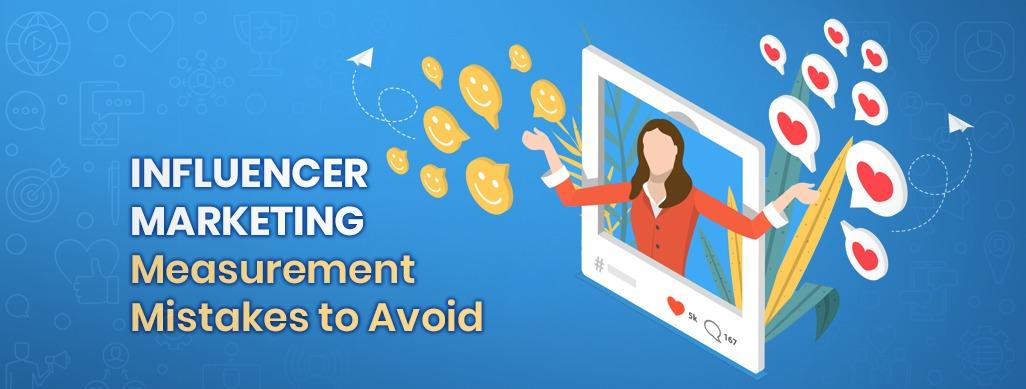
Quick Summary: In this post, we'll explore seven common mistakes brands make when measuring their influencer marketing efforts and provide insights on how to avoid them.

Influencer marketing has become an essential part of many brands’ marketing strategies. With the rise of social media and the increasing importance of authenticity and peer-to-peer recommendations, influencers can be powerful partners for promoting products and services. However, measuring the success of influencer marketing campaigns can be a challenge. In this post, we’ll explore seven common mistakes brands make when measuring their influencer marketing efforts and provide insights on how to avoid them.
One of the biggest mistakes brands make is attempting to measure aspects of influencer marketing that are inherently unmeasurable. While it’s important to track quantifiable metrics like impressions, engagement rates, and website traffic, some of the most valuable benefits of influencer marketing are intangible. These include building brand awareness, establishing credibility, and fostering long-term relationships with influencers and their followers.
Trying to assign a dollar value to these intangible benefits can be futile and may lead to inaccurate or misleading conclusions. Instead, brands should focus on measuring the tangible outcomes that align with their specific campaign goals, such as sales, lead generation, or increased website traffic. For the intangible benefits, brands can rely on qualitative feedback from influencers, followers, and internal stakeholders.
While it’s important to track relevant metrics, measuring too many Key Performance Indicators (KPIs) can be counterproductive. Collecting and analyzing excessive data can lead to information overload, making it difficult to identify the most meaningful insights.
Before launching an influencer marketing campaign, brands should carefully select a handful of KPIs that directly align with their campaign objectives. These could include impressions, engagement rates, website traffic, conversions, or sales, depending on the goals. By focusing on a few essential metrics, brands can streamline their analysis and make more informed decisions about optimizing their campaigns.
Some brands fall into the trap of trying to assign a monetary value to every metric they track, even when it’s not appropriate or accurate to do so. While it’s important to understand the financial impact of influencer marketing campaigns, not every KPI needs to be translated into dollars and cents.
For example, while it may be possible to estimate the value of a website visit or a conversion, it’s not always meaningful or accurate to assign a dollar value to impressions or engagement rates. These metrics are often better understood as indicators of brand awareness, reach, and audience engagement, rather than direct revenue drivers.
Brands should carefully consider which KPIs truly represent financial value and focus their monetary calculations on those metrics, while using other KPIs as complementary indicators of campaign success.
Influencer marketing measurement requires a rigorous and consistent approach. Without a well-defined measurement strategy and clear processes for data collection and analysis, brands may end up with incomplete or unreliable data that fails to accurately represent the impact of their campaigns.
To avoid this mistake, brands should establish a comprehensive measurement plan before launching an influencer marketing campaign. This plan should include:
By taking a rigorous and disciplined approach to measurement, brands can ensure they have reliable and actionable insights to inform their influencer marketing strategies.

While it’s important to choose KPIs that align with campaign objectives, brands must also ensure they have the capability to accurately track and measure those KPIs. Selecting metrics that are difficult or impossible to measure can undermine the effectiveness of the entire measurement strategy.
For example, if a brand wants to track sales attributed to an influencer marketing campaign, they need to have robust tracking mechanisms in place to connect influencer content with actual purchases. Without proper attribution models and data integration, accurately measuring sales impact can be challenging.
Before finalizing their KPIs, brands should carefully assess their ability to collect and analyze the necessary data. If certain metrics are not feasible to track, they should consider alternative KPIs that better align with their measurement capabilities.
While it can be tempting to emulate the measurement practices of successful brands, this approach can be misleading if the brands in question have vastly different business models, target audiences, or campaign objectives.
For example, a direct-to-consumer e-commerce brand might prioritize sales and conversion metrics, while a luxury fashion brand might focus more on brand awareness and engagement metrics. Blindly adopting the measurement strategy of the e-commerce brand could lead the fashion brand to overlook critical indicators of success for their influencer marketing campaigns.
Instead of emulating other brands, companies should carefully assess their own unique business objectives, target audience, and marketing goals. This will help them identify the most relevant KPIs and measurement approaches tailored to their specific needs.
Finally, some brands fall into the trap of measuring influencer marketing campaigns solely for the purpose of boasting about their success, rather than using the insights to continually optimize and improve their strategies.
While celebrating campaign achievements is certainly warranted, measurement should be a means to an end – a tool for uncovering valuable insights that can inform future decision-making and drive better results.
Instead of focusing solely on success metrics, brands should also analyze areas for improvement, such as underperforming content, ineffective influencer partnerships, or missed opportunities for audience engagement. By taking a holistic and objective approach to measurement, brands can identify both strengths and weaknesses, and use those insights to refine their influencer marketing tactics.
Influencer marketing measurement is a critical aspect of any successful campaign, but it’s also an area where many brands struggle. By avoiding the seven mistakes outlined in this post – measuring the unmeasurable, measuring too much, placing an unnecessary $ sign in front of every KPI, lacking rigor in your measurement approach, selecting KPIs you can’t track, emulating brands you have little in common with, and measuring solely to gloat – brands can develop more effective and insightful measurement strategies.
Ultimately, the key to successful influencer marketing services measurement is to align your metrics with your specific campaign objectives, prioritize rigor and consistency in your data collection and analysis, and use the insights to continually optimize and refine your influencer marketing strategies over time.
Join our growing community and get inspiring articles.
Our highly trained talented teams are committed to providing you with top-level, technical or any other support 24*7.
Ready to get started? Give us a call.